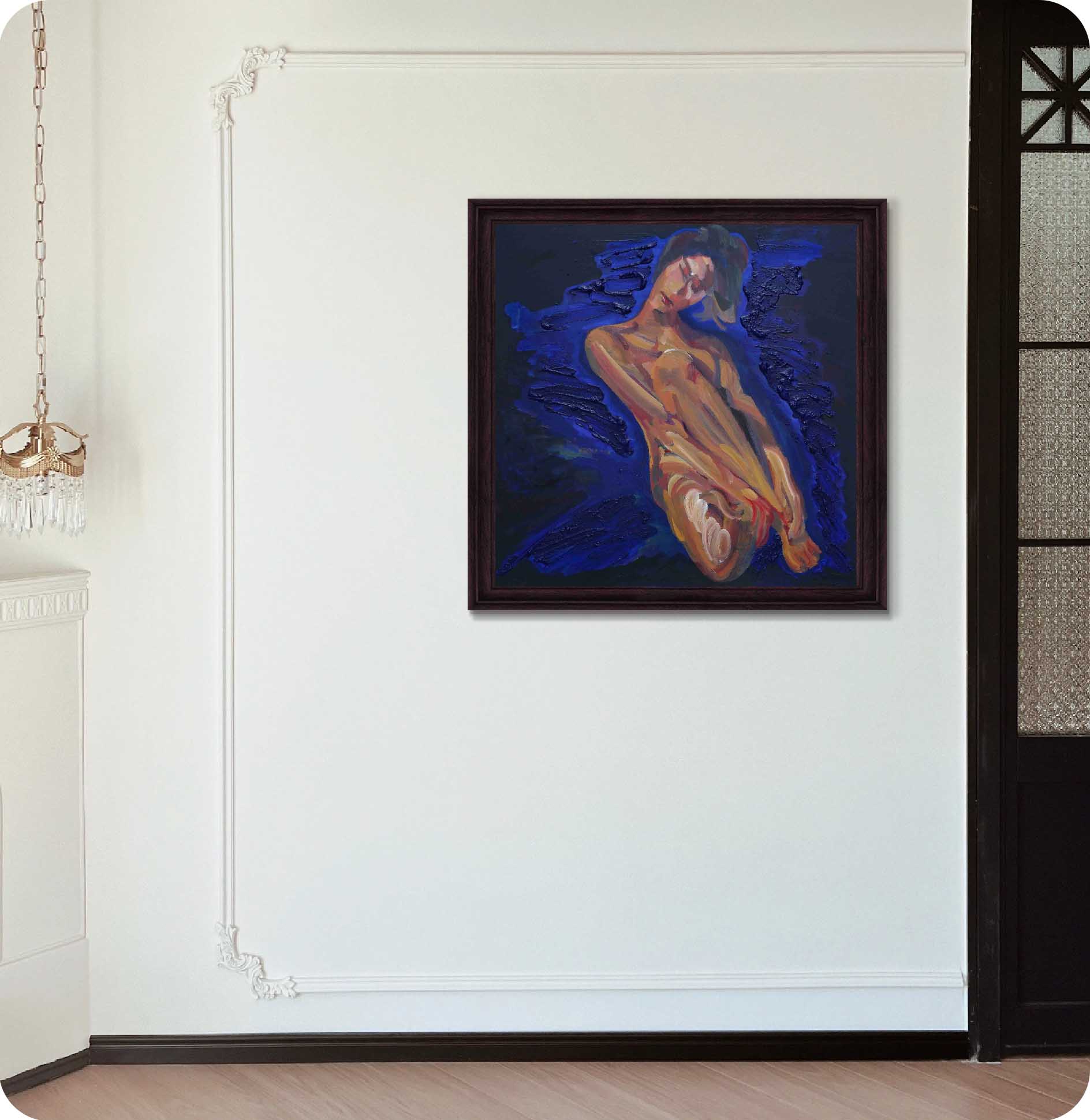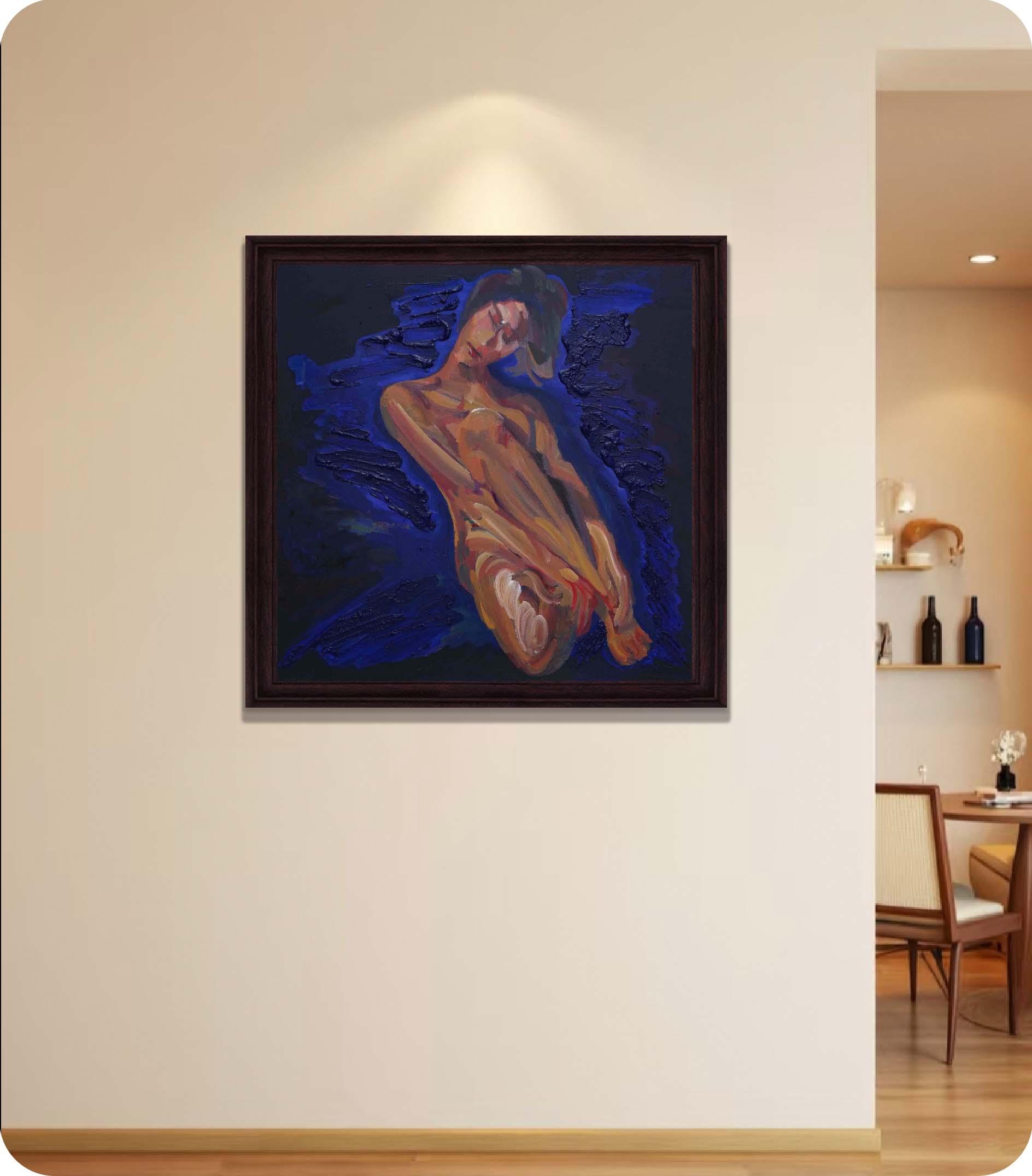The theme of this year's painting clearly states one - the makeup of desire. People's various desires are wrapped under various makeups. Desires are the intertwining of happiness and pain in life. Either straightforward or subtle, they will appear in makeup, forming a profound look of an era.
Inches: 23.6 x 23.6 in
Size without the frame: 60 x 60 cm
Country: China
Date: 2025
Materials: Acrylic and oil painting on wood
Condition: well preserved
Creative themes and style | My works revolve around the creative concept of "The land of humanity, and the people upon it" . The people in the painting are people in nature, and the lines, shapes, and colors are close to nature. The nature in the painting is nature in the eyes of humans, existing in interaction with humans.I don’t pursue a series of works with a fixed and continuous style. I hope that the style of the pictures will synchronize with the changes in my life and always remain oscillating. The performance of the work must be in sync with the development of one's own life in order to be Sincere and powerful.Ideas are later.
An Interview with Artist Philo by Artphiloso Gallery
If you would like to collect this artwork or know more about the artist, please contact us.


Theme and Imagery: The painting centers on a solitary nude figure, presenting a body language that is both restrained and expressive. The body is depicted as a landscape of emotion, where the silence of a summer night collides with inner unease. The flesh tones and deep blues are interwoven, pulling against each other to reveal a state of psychological tension.
Form and Detail: The artist avoids strict anatomical realism, instead reconstructing the body through bold planes and fluid brushwork. The arms and knees are extended, with joints emphasized through folded color planes, while the fingertips are rendered in short, crisp strokes that accentuate fragility. Certain areas convey solid mass, while others appear vulnerable, achieving a delicate balance between weight and fragility.
Composition and Perspective: Within the square canvas, the figure is positioned diagonally at the center, with the head tilted gently downward. This asymmetrical framing intensifies a sense of movement and unresolved direction, drawing the viewer close yet holding them at the edge of the subject’s inner world.
Color Strategy: The entire work is grounded in deep blue, while the body is layered with warm hues to form a striking contrast of temperature. Ochre, brick red, and golden tones are woven into the flesh, creating the effect of light as if it were heat in motion. The blue background serves as an emotional negative, while the warm body tones radiate heat into the surrounding darkness.
Brushwork and Texture: The painting juxtaposes thick impasto with thin glazes. In the background, heavy palette-knife textures create coarse, tactile surfaces, while the figure is shaped by fluid, elongated strokes. The interplay of hard and soft edges makes the body appear simultaneously carved and caressed, evoking a layered tactile experience.
Content and Thematic Expression: The work reflects on how the body embodies time and emotion. The closed posture suggests resistance to external intrusion, while the variations in temperature across the flesh resemble the echoes of memory on the skin. The body becomes a metaphor for the struggle between solitude, desire, and self-protection.
Emotion and Viewer Interaction: The face is softened, the eyes turned inward, preventing the viewer from directly accessing a narrative expression. Instead, the painting compels attention through atmosphere. The viewer experiences a mix of empathy and detachment, a central strategy in the work’s emotional design.
Unconventional Observations: The textured blue areas are more than background—they act as strata of memory or scars, surrounding the figure with both protective and invasive qualities. Meanwhile, the shifts of color around the knees and shoulders resemble geological folds, suggesting an internal narrative that runs through the body like hidden terrain.
In sum, this piece employs contemporary figurative methods—color contrasts, painterly textures, and cropped composition—to create a portrait that is both physical and introspective. It emphasizes the relationship between extension and contraction, movement and stillness, and achieves a fusion of visual decoration and psychological depth, firmly situating it within the discourse of contemporary figurative painting.
Egon Schiele, “Seated Male Nude” (c.1910) — Comparable in its exaggerated gestures and elongated body forms.
Francis Bacon, “Study after Velázquez” (1950) — Resonates through its distorted anatomy and atmosphere of psychological pressure.
Henri Matisse, “La Danse” (1910) — Relevant in its decorative use of color and rhythmic compositional flow.
Edgar Degas, “Dancers Practicing” — Echoes the cropped framing and intimate immediacy of bodily movement.
A1: The dense textures of indigo and Prussian blue form rugged surfaces that serve not only as background but also as strata of memory and emotional boundaries. They surround the figure, amplifying contrast and making the warm body tones more luminous.
A2: The abrupt turns in color resemble geological folds, reinforcing the functionality of joints while suggesting nodes of inner emotion. They establish a visual rhythm between action and stillness across the body.
A3: At 60x60cm, it is ideal for modern galleries, boutique apartments, or corporate reception spaces. Directed lighting enhances its textured brushwork, making it especially suitable as decorative wall art or as a focal point in a themed exhibition.
A4: As a contemporary figurative painting, its value is closely tied to the artist’s reputation, year of creation, and condition. Works of this nature appeal to collectors and galleries seeking pieces with both display strength and scholarly relevance, offering mid- to long-term potential for appreciation within the art collection and curatorial context.
A5: Descriptions should highlight its expressive figurative quality, textured brushwork, emotional contrasts of warm and cool color, and suitability as modern interior art. Positioned as expressive nude art and contemporary collectible, it appeals to buyers seeking artworks that enhance narrative depth and atmosphere within living spaces, creative offices, or curated exhibitions.
What should I pay attention to when buying an artwork or its derivatives?
A: Click here to view ARTPHILOSO's Guide for Collectors.
More paintings from this series:
A Restless Summer 1 A Restless Summer 2 A Restless Summer 3 A Restless Summer 4 A Restless Summer 5
A Restless Summer 6 A Restless Summer 7 A Restless Summer 8 A Restless Summer 9 A Restless Summer 10
A Restless Summer 13 A Restless Summer 14 A Restless Summer 15 A Restless Summer 16
